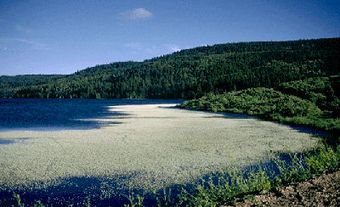Whiteshell Provincial Park (established 1961, 2737.15 km2), 105 km E of Winnipeg, Manitoba, by the Trans-Canada Highway, is Precambrian SHIELD country. Whiteshell is connected to Nopiming Provincial Park to the north.
Natural History
Glaciation acting on the 3.75-billion-year-old rocks has formed many lakes and granite outcrops. West Hawk Lake, the deepest in Manitoba (111 m), is believed to have been created by a METEORITE. Most of the area is forested, with both coniferous and deciduous species; numerous wetland plants occur (eg, lilies, wild rice). Mammals include black bears, moose, deer, coyotes, beavers and mink. Bird life is varied, Canada geese being especially abundant at the Alfred Hole Sanctuary.
Human History
Native North American presence can be traced archaeologically to 3000 BC and is revealed in petroglyphs at Bannock Point. In 1733-34 Jean-Baptiste LA VÉRENDRYE traversed the area via the Winnipeg River; other explorers (eg, MACKENZIE, THOMPSON, HENRY, KANE) followed. The transcontinental railway was built in the 1880s and sporadic mining, logging and farming occurred. In the 1920s, the area's recreation potential was recognized, cottages were developed and, in 1931, a forest reserve was established.
Facilities
The park is accessible by several roads, although the northeast section remains a roadless wilderness. Facilities are available throughout the park with 11 year-round resorts and an additional 18 resorts open May-September. Activities include boating, fishing, swimming, camping, horseback riding and interpretation events and, in winter, downhill and cross-country skiing and SNOWMOBILING. Many canoe routes, day-use or interpretive hiking trails, and the 60 km Mantario wilderness trail are available.

 Share on Facebook
Share on Facebook Share on X
Share on X Share by Email
Share by Email Share on Google Classroom
Share on Google Classroom

